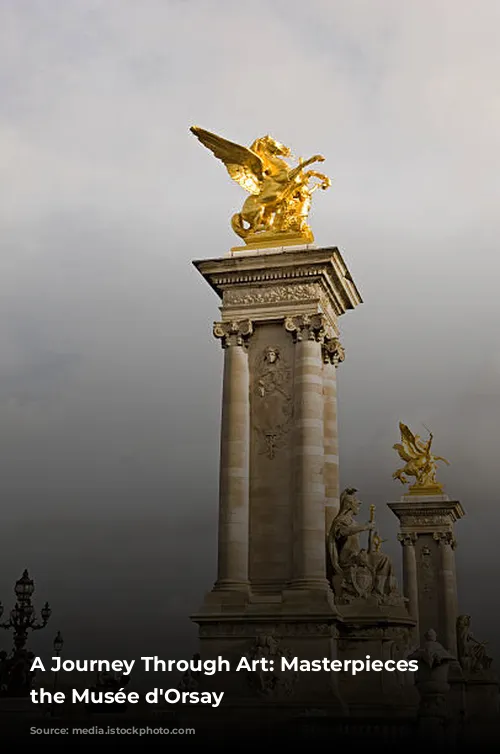The Musée d’Orsay, a magnificent Parisian museum housed in a former railway station and hotel, holds a captivating collection of French art from the late 19th and early 20th centuries. It’s a popular destination for art enthusiasts, and this article showcases just a small selection of its treasures.

The Angelus: A Story of Faith and Nostalgia
Jean-François Millet’s iconic painting, The Angelus, is one of the most recognizable works of art from the 19th century. Its image was widely reproduced and adorned Christian homes, though cartoonists couldn’t resist poking fun at its sentimental nature. The Angelus, a prayer recited three times daily in Catholic countries, inspired Millet’s work, but not out of religious devotion. He, a man of humble origins, drew inspiration from his childhood memories. The sound of the church bell would signal his family to stop working and remember the departed. The painting’s portrayal of a woman deeply engrossed in prayer, while her husband merely holds his hat, subtly reflects the traditional gender roles of the time.
Despite initial controversy surrounding some of his other paintings, The Angelus rapidly became Millet’s most celebrated work. It sold for a staggering sum in the 1890s, making headlines across France.

Degas: A Glimpse into Family Life
Edgar Degas is known for his innovative approach to portraiture, a trait evident in his painting The Bellelli Family. This remarkable work, crafted during his time in Italy studying the masters, showcases Degas’s unique “freeze-frame” style. Each family member seems caught in a fleeting moment, their gaze directed in different directions, creating a sense of both intimacy and isolation.
The portrait, painted while Degas’s aunt Laure mourned the passing of her father, captures the somber mood of the Bellelli family. The colors are muted, creating a sense of claustrophobia, while the portraits, mirrors, and doorways add to the complexity of the composition. The Bellelli Family exemplifies Degas’s signature style, where the seemingly casual details are carefully orchestrated, reflecting his philosophy: “No art was ever less spontaneous than mine.”

Pissarro: Impressionism in the Countryside
Camille Pissarro, often hailed as the father of French Impressionism, found inspiration in the rural landscapes surrounding Pontoise. His painting, The Red Roofs, captures the essence of the countryside, with farm buildings nestled on a hillside called La Côte des Boeufs.
The painting is a testament to Pissarro’s mastery of color and technique. He uses short, layered brushstrokes, creating a vibrant tapestry of colors that harmonize from a distance. The composition, with its horizontal roofs and angled buildings, guides the viewer’s eye through the scene.
Pissarro constantly experimented with his style, and The Red Roofs exemplifies his dedication to capturing the natural world through a subjective lens. He sought to record the pure effects of color and tone, a central theme in Impressionism.

Van Gogh: A Personal Reflection in “The Bedroom”
Vincent van Gogh’s The Bedroom is a poignant portrayal of his personal life and struggles. This third version of the painting, created during his stay in a mental asylum, stands in stark contrast to the first two. The vibrant pink floor of the earlier versions has been replaced with a somber brownish-gray, mirroring his depressed state.
The Bedroom is filled with symbolic details, such as the paired items, signifying his yearning for companionship. However, the friendship with Gauguin, which he had hoped to nurture in this house, ended tragically. The painting also features a more distinct portrayal of two portraits: van Gogh himself and his sister Wil, adding a personal touch to the scene.
This final version of The Bedroom was painted for his mother, and it serves as a testament to his artistic genius, even in the face of adversity.

Toulouse-Lautrec: A Glimpse into Parisian Life
Henri de Toulouse-Lautrec, a prominent figure in the Parisian art scene, delved into the hidden corners of the city. His fascination with the lives of its inhabitants, particularly those in cafes, circus, and brothels, led him to depict the human condition with sensitivity and honesty.
The Bed is part of a series of works that capture the intimate moments of lesbian relationships, showcasing Lautrec’s commitment to portraying the complexities of human experience. He avoids moralizing or romanticizing, offering a raw and empathetic glimpse into their lives.
Lautrec’s artistry is characterized by a unique combination of bold colors, expressive lines, and movement. He masterfully captured the human spirit, revealing both the beauty and the weariness of his subjects.









